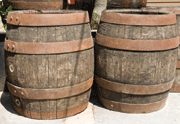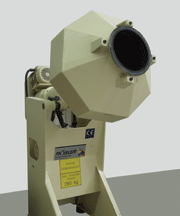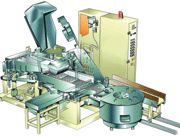E-Archive
Good Vibrations
in Vol. 10 - March Issue - Year 2009
The Origins Of Mass Finishing





A modern mass finishing machine
Last August I reached a personal career milestone of 30 years in the Mass Finishing industry. Whilst this may seem like a long time to some people, the Mass Finishing process goes back very many more years, so I thought it may be appropriate to take this opportunity to look back to the origins of the technique and how it all began.
The background to the process
It might be said that the origins of the process can best be seen as nature’s way of smoothing and polishing a variety of materials.
For example, you rarely see a pebble on the seashores that has not been smoothed and rounded by the tumbling action of the waves and the abrasive action of the sand granules. This action is perfectly reproduced in the early barrelling machines and later in vibratory and centrifugal systems.
The origins of the process in more recent times of man’s history may well have come from the fact that in roman times soldiers would carry their armour and harness fittings in bags of sand slung across their horses back.
The abrasive action thus generated by the movement of the horse kept the parts clean and bright for ceremonial occasions.
The history of the process
The earliest records of barrel finishing are to be found in patents taken out in the mid 19th century, about the year 1850.
Early machines were quite simple. Wine casks or beer barrels were mounted on simple bearing systems and usually turned by hand. Into the barrels the components would be placed, usually without media. Mostly the process was used to remove moulding sand and scale from sand castings prior to machining or other finishing processes.
Later on they attempted to improve the process by adding crude forms of media. This usually comprised natural or easily obtained materials which included metal swarf, small cast star shapes, steel shot, coke, granite or limestone chippings and for polishing they used a mixture of old machine and emery with pieces of worn leather machine drive belts.
Surprisingly quite good results were sometimes achieved by these rather crude methods but the process was hit and miss and was restricted to components of low value which could withstand the harsh treatment to which they were submitted. However, it was from such beginnings the modern processes and machines were evolved.
Development in the field of mass finishing grew rapidly from these simple beginnings, this was brought about by the equally rapid growth of technology in product manufacture in the engineering industry. The increase in the production of precision components made it necessary that more efficient and less labour intensive ways should be found to deal with the finishing of the parts.
In 1935 a committee was set up in the USA to investigate means by which these problems might be solved. They quickly saw that the needs of the industry might well be served by a development of those crude barrelling or as they were often known ‘rumbling’ processes.
All the subsequent developments in the processes and the equipment have grown from these early beginnings.
These early developments have played (and still do) a significant roll in the growth and status of the contemporary Mass Finishing Industry.
Good Vibrations
by Paul Rawlinson,
Contributing Editor MFN and
General Manager Rösler US
Tel: +44.151.482 0444
Fax: +44.151.482 4400
E-mail: prawlinson@rosler.us




























